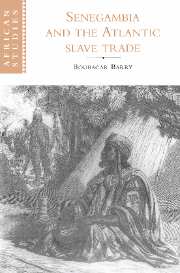Book contents
- Frontmatter
- Contents
- Preface
- Map
- I Senegambia from the fifteenth to the seventeenth century: a haven for incoming populations, a station for migrants on the move
- II Senegambia in the eighteenth century: the slave trade, ceddo regimes and Muslim revolutions
- III Senegambia in the first half of the nineteenth century: legitimate trade and sovereignty disputes
- IV Senegambia in the second half of the nineteenth century: colonial conquest and resistance movements
- Conclusion
- Notes
- Bibliography
- Index
- Other books in the series
IV - Senegambia in the second half of the nineteenth century: colonial conquest and resistance movements
Published online by Cambridge University Press: 31 October 2009
- Frontmatter
- Contents
- Preface
- Map
- I Senegambia from the fifteenth to the seventeenth century: a haven for incoming populations, a station for migrants on the move
- II Senegambia in the eighteenth century: the slave trade, ceddo regimes and Muslim revolutions
- III Senegambia in the first half of the nineteenth century: legitimate trade and sovereignty disputes
- IV Senegambia in the second half of the nineteenth century: colonial conquest and resistance movements
- Conclusion
- Notes
- Bibliography
- Index
- Other books in the series
Summary
Waalo was conquered in 1855. Shaykh Umar was defeated at Medina in 1857. The two events marked the real beginning of the partition of Senegambia by the French, the British, and the Portuguese. The process of partition, lasting until the end of the nineteenth century, involved a long series of military campaigns punctuated by lulls and periods of negotiation. As it unfolded, the states and peoples of the region resisted colonial conquest in a variety of ways. The drive toward colonial conquest was fragmented on account of competition between the European powers. The process was therefore jumbled, with piecemeal advances here, uncoordinated thrusts there; hence the artificiality of today's frontiers in the Senegambian region.
Colonial conquest took place against a historical background in which the major economic issues of the first half of the nineteenth century remained essentially unresolved. The heat of military activity, combined with the clash of rival European powers, tended to blur the motives behind the new European drive toward empire that emerged after the mercantilism of the previous centuries. Indeed, the conquest of Senegambia was an integral part of a general context of colonial imperialism in which the dominant concern was the determination of Europe's industrial states to carve up the world.
- Type
- Chapter
- Information
- Senegambia and the Atlantic Slave Trade , pp. 207 - 212Publisher: Cambridge University PressPrint publication year: 1997



